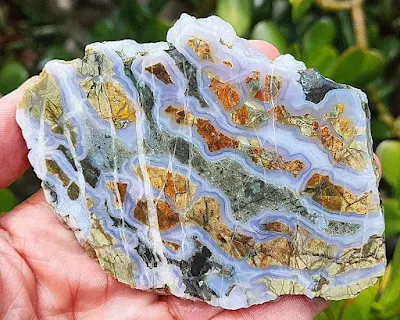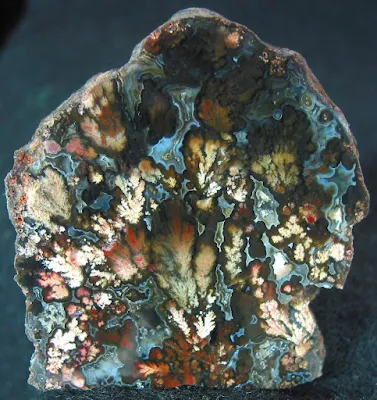Plume Agate: Types, Properties, Value
Plume Agate
Plume agate is a variety of chalcedony, a microcrystalline quartz, characterized by delicate, plume-like inclusions of various colors and minerals. These inclusions often resemble feathers, flowers, or flames, giving the agate a unique and visually appealing appearance. The plumes are typically composed of iron oxides, manganese oxides, or other trace minerals that were deposited during the agate's formation.
Formation of Plume Agate
Plume agate forms in hydrothermal environments, where hot, silica-rich fluids circulate through volcanic rocks. These fluids dissolve silica and other minerals and deposit them in cavities or voids in the rocks. Over time, the deposited silica accumulates and recrystallizes, forming layers of chalcedony. The plume-like inclusions are formed when trace minerals in the hydrothermal fluids mix with the silica during the recrystallization process. The coloration depends on the specific trace minerals involved.
.jpg) |
| Plume Agate |
Properties of Plume Agate
Composition: SiO₂ (Silicon Dioxide) with inclusions of iron and manganese oxides (forming the plumes) - Same as chalcedony.
Color: White, gray, milky, yellow, green, red, orange, sometimes with banded or mottled patterns due to the plumes.
Luster: Vitreous to waxy, depending on the specific type of plume agate.
Crystal System: Microcrystalline aggregate, not a true crystal system.
Streak: White
Hardness: 6.5-7 on the Mohs scale (slightly softer than quartz)
Cleavage: Poorly developed to conchoidal
Crystal Form: Usually botryoidal, banded, or massive.
Density: 2.60-2.65 g/cm³ (similar to density of water)
Transparency: Translucent to opaque, depending on the thickness and density of the plumes.
Fracture: Conchoidal to uneven
Solubility: Insoluble in water and common acids, slightly soluble in strong alkalis.
Magnetism: Non-magnetic
Fluorescence: Varies depending on the type of plume, some may exhibit weak orange or yellow fluorescence under longwave ultraviolet light.
Pleochroism: Absent, due to the non-crystalline nature of plume agate.
Refractive Index: Typically around 1.54-1.55 (similar to chalcedony)
Varieties and Types of Plume Agate
There are several different varieties of plume agate, each with its own unique characteristics and appearance. Some of the most well-known varieties include:
Moss Agate
.webp) |
| Moss Plume Agate from Indonesia |
Moss Agate: While not technically a true plume agate, moss agate is often included in this category due to its feathery, moss-like inclusions. The mossy patterns, often in shades of green, brown, and black, create a captivating and earthy aesthetic. Moss agate considered a type of plume agate due to its plume-like features, but not all plume agates are moss agate.
Dendritic Agate
 |
| Dendritic agate variety of plume agate Photo: Rare Earth Mining Co. |
Dendritic agate: This type showcases fern-like or tree-like inclusions of black manganese oxides, creating a mesmerizing contrast against the agate's base color.
Fire Agate
 |
| Fire agate variety of plume agate |
Fire agate: This type of plume agate features red or orange inclusions of iron oxides, giving it a fiery appearance. The defining feature of fire agate is its fiery red and orange plume formations. These inclusions often resemble flames flickering upwards, giving the stone its captivating name. In some cases, the agate may also have accents of white, yellow, or even black.
Brecciated Agate
 |
| Brecciated Agate Photo: Roy Isaac |
Brecciated Plume Agate: Formed from fragments of agate and plume agate, brecciated plume agate is known for its mosaic-like appearance. The contrasting colors and textures of the fragments create a captivating and visually striking gemstone.
Brecciated plume agate is known for its captivating and visually striking appearance. The contrasting colors and textures of the fragments, along with the delicate plume-like inclusions, create a mosaic-like pattern. The plume structures can be wispy and feathery, resembling feathers, flowers, or even flames. The color palette can vary depending on the location and the mineral inclusions, but common colors include white, brown, red, yellow, and orange.
Phantom agate
 |
| Cut Plume agate. Photo: Didiek Backbone |
Phantom agate: Phantom plume agate is a type of plume agate that features faint, ghost-like inclusions within the stone. These inclusions are much more subtle compared to regular plume agate and are only truly visible when held up to light. The base color of the agate can vary depending on the location and mineral inclusions, but common colors include white, brown, red, yellow, and orange.
Uses of Plume Agate
Plume agate is a popular gemstone and is often used in jewelry making. It is also used for decorative purposes, such as in carvings, sculptures, and cabochons. Plume agate is believed to have various metaphysical properties, such as enhancing creativity, balance, and emotional well-being.
Due to its unique appearance, plume agate finds several uses:
Jewelry: Plume agate is often crafted into beautiful jewelry pieces like pendants, earrings, rings, and bracelets. The intricate patterns within the stone make each jewelry item unique and visually striking.
Ornamental Objects: Plume agate is sometimes used in ornamental objects like paperweights, decorative bowls, and sculptures. Its mesmerizing patterns add a touch of elegance and intrigue to any space.
Healing and Spiritual Practices: Some people believe in the metaphysical properties of plume agate for healing and spiritual purposes. It is thought to promote inner peace, balance, and harmony.
Collectibles: Collectors are often drawn to plume agate for its unique beauty and rarity. Specimens with particularly intricate plume formations are highly sought after by collectors of gemstones and minerals.
Lapidary Art: Plume agate is a favorite among lapidary artists who enjoy cutting and polishing stones. Its unique patterns and colors offer endless creative possibilities for making custom cabochons, beads, and other lapidary creations.
Gifts and Souvenirs: Plume agate items make thoughtful and memorable gifts for friends, family, or colleagues. Whether it's a piece of jewelry or a decorative object, plume agate gifts are sure to be appreciated for their beauty and uniqueness.
 |
| Bouquet type, plume agate, from Presidio County, Texas. Photo: Darwin R. Dillon |
Value of Plume Agate
The value of plume agate varies depending on the quality, size, and color of the stone. High-quality plume agate with vibrant colors and intricate plumes can fetch high prices in the gemstone market.
Plume Agate occurrence
Some of the most notable localities for plume agate:
Oregon: The John Day Formation in central Oregon is one of the most famous localities for plume agate. This formation is also home to other types of agate, including moss agate and fire agate.
California: Plume agate is found in several locations in California, including the Mojave Desert, the Sierra Nevada Mountains, and the Death Valley National Park.
Nevada: Nevada is home to some of the largest and most spectacular plume agate specimens in the world. These specimens are typically found in the northern part of the state, near the Nevada-Idaho border.
.jpeg) |
| Turkish plume agate Photo: Recepimal08 |
Texas: Plume agate is found in the Woodward Ranch in Alpine, Brewster County, Texas.
Colorado: Plume agate is found in several locations in Colorado, including the San Juan Mountains and the Del Norte area.
Ashcroft, British Columbia, Canada: Plume agate is found in the Ashcroft area of British Columbia.
Turkey: Plume agate is found in Turkey, particularly in the Eskişehir Province.
Iran: Plume agate is found in Iran, particularly in the Khorasan Province.
Indonesia: Plume Agate is found on the Indonesian island of Java. The agate in this region is typically characterized by its white or gray background with delicate feather-like plumes of red, brown, or black. The Plume Agate from Java is often referred to as "Indonesian Moss Agate" because of its resemblance to moss.
 |
| Dendritic plume agate |

%20(1).webp)






